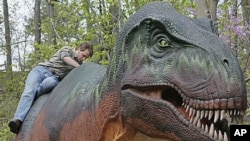Paleontologists in Canada say the massive teeth of the fearsome dinosaur species known as Tyrannosaurus rex were not just great for ripping the flesh and crushing the bones of its prey, but also played specialized roles in the feeding process depending on their shape and position in the creature’s mouth.
More than 65 million years ago, a huge, open mouth lined with jagged teeth likely was the last thing ever glimpsed by many prehistoric animals the moment before they were devoured by a T. rex - the largest-known carnivore ever to walk the Earth.
The dinosaur's teeth had varied shapes and sizes, and researchers at the University of Alberta now believe each variety had a different purpose. A tooth's job was determined by the serrations along its edge, its angle in the jaw, and its location in the T. rex’s mouth, their study concludes.
Some teeth were designed for cutting through flesh and bone, while others helped direct the food into the dinosaur’s mouth.
The scientists say T. rex had the greatest variation in tooth form or structure of any species in the tyrannosaurid family of meat-eating dinosaurs.
The study results show that teeth in the front of a T. rex's mouth gripped and pulled the prey, while puncturing and tearing was done by teeth on the sides of the jaw. Teeth located at the back of the mouth sliced-and-diced the prey into small chunks, and then helped force the food into the back of the predator’s throat.
The paleontologists also note that T. rex teeth were quite dull and wide - almost banana-like in shape - which would have prevented them from breaking as the dinosaur clamped its jaws down on its prey.
The new study is published in The Canadian Journal of Earth Science.
Tyrannosaurus rex and all other dinosaurs were permanently wiped out 65 million years ago in a catastrophic mass extinction that marked the end of the Cretaceous geologic period.
News
Tyrannosaurus Rex Chomped on Prey With Specialized Teeth






